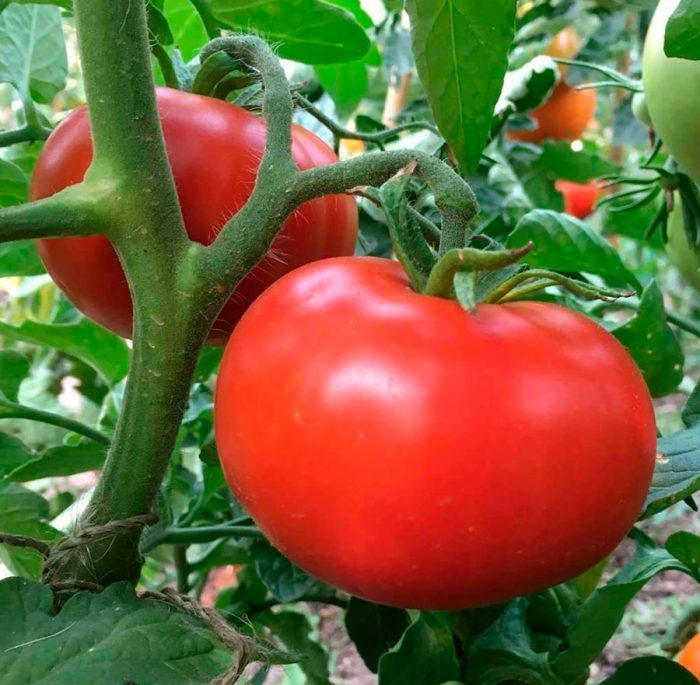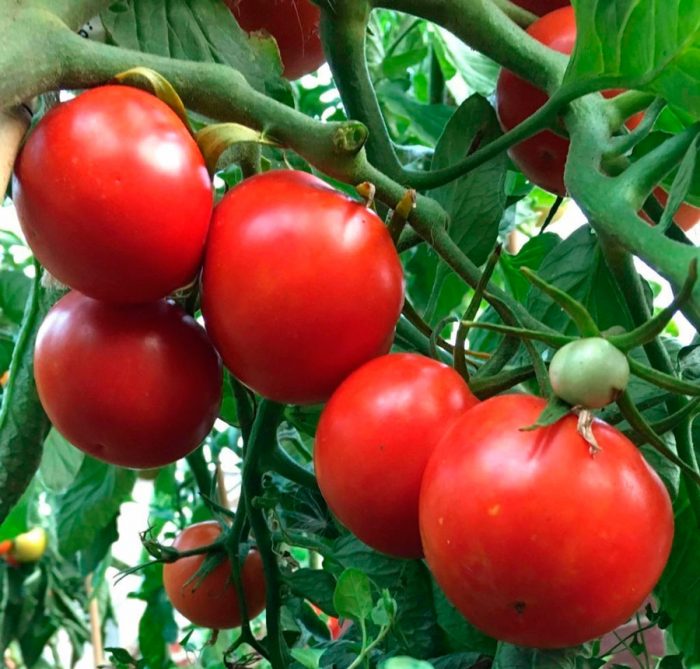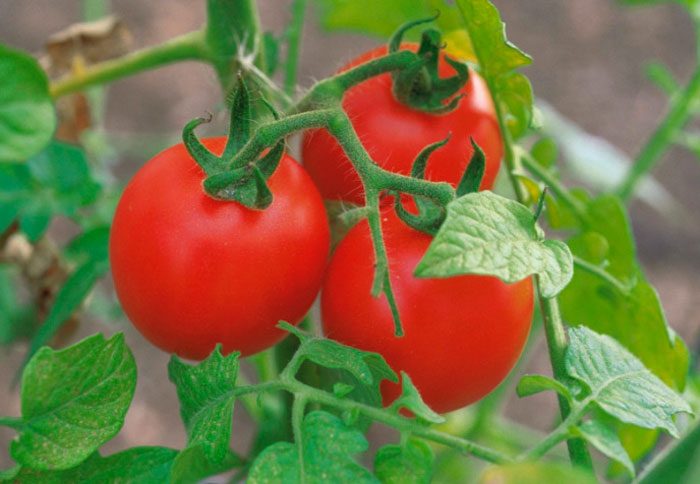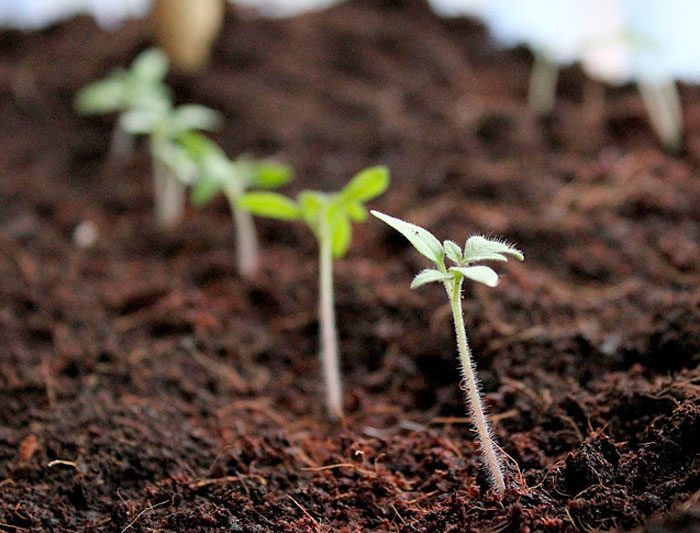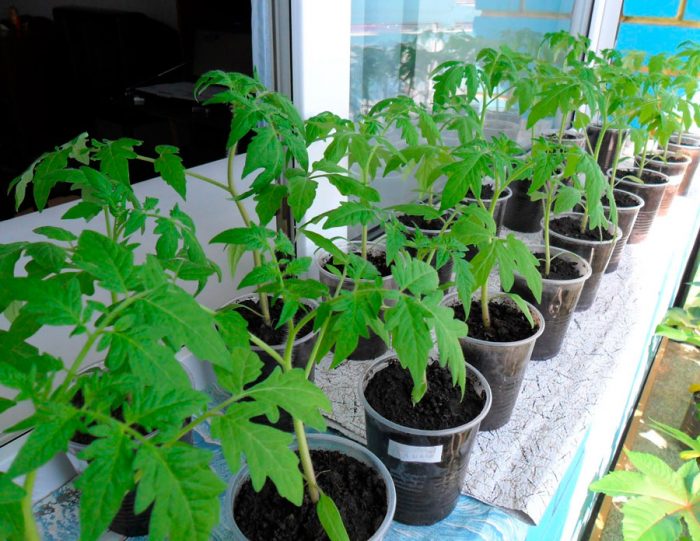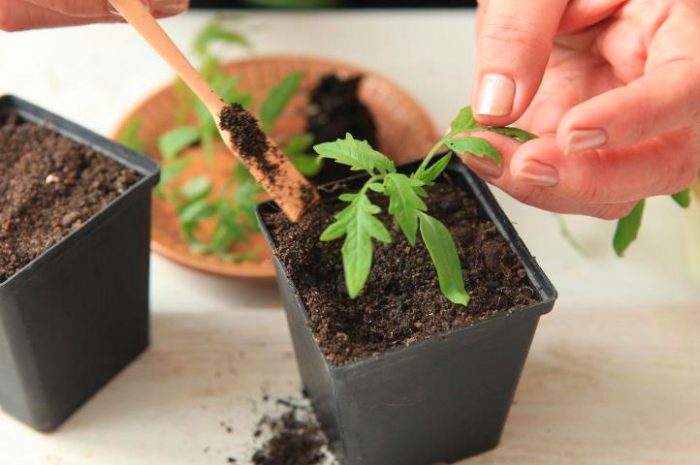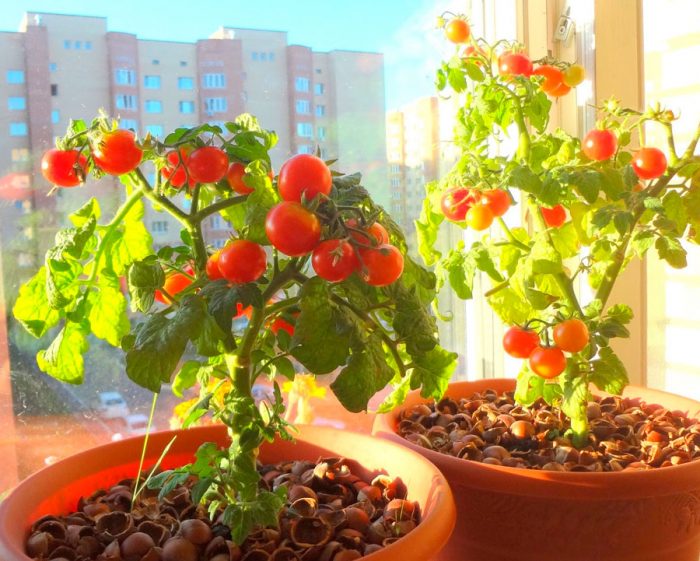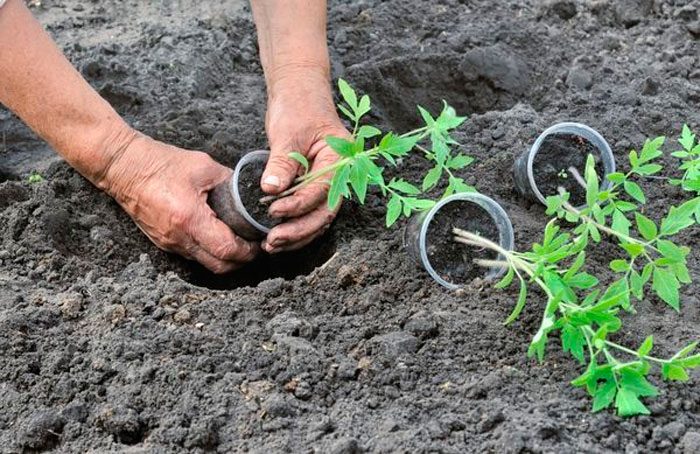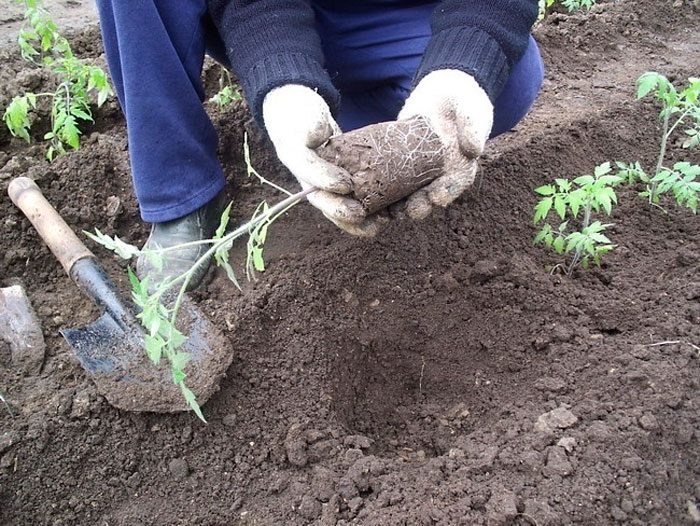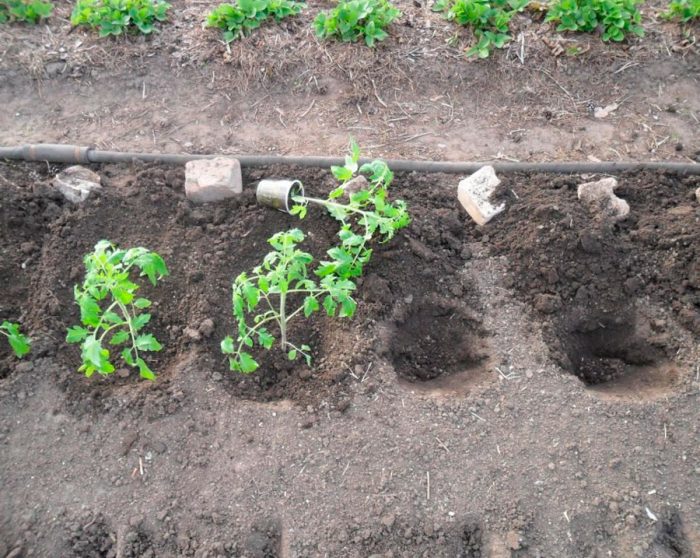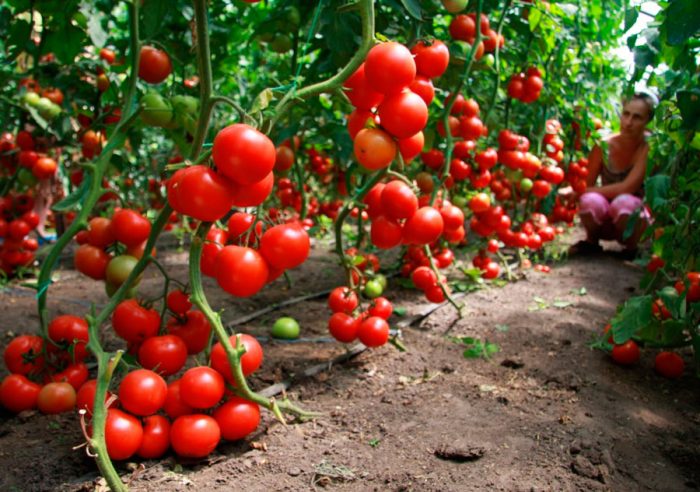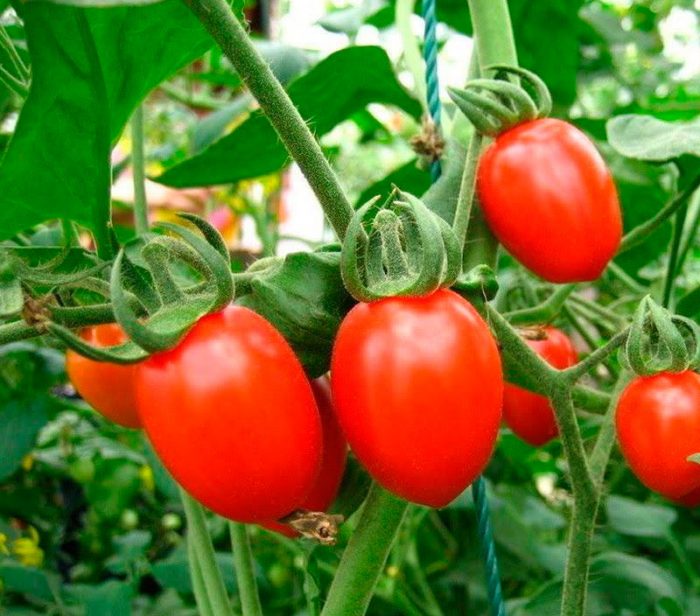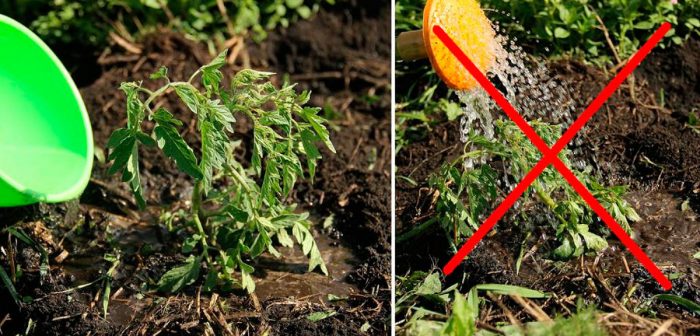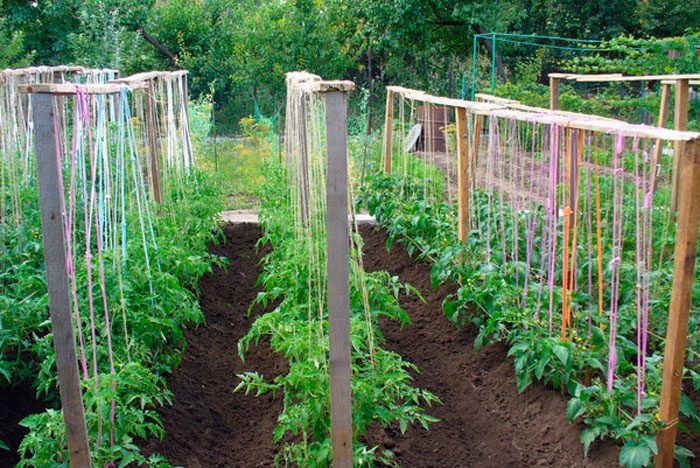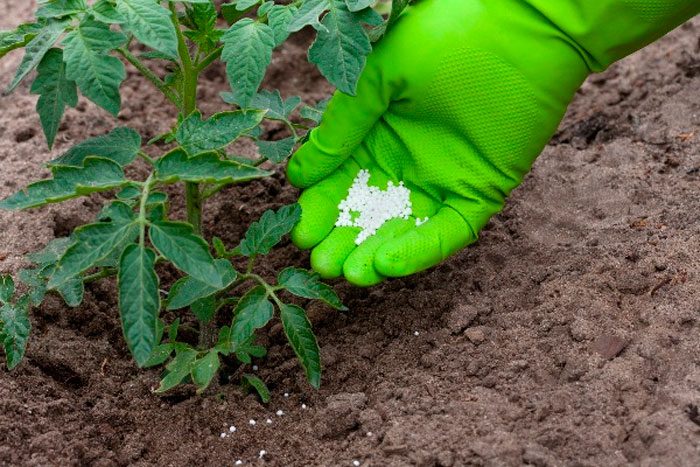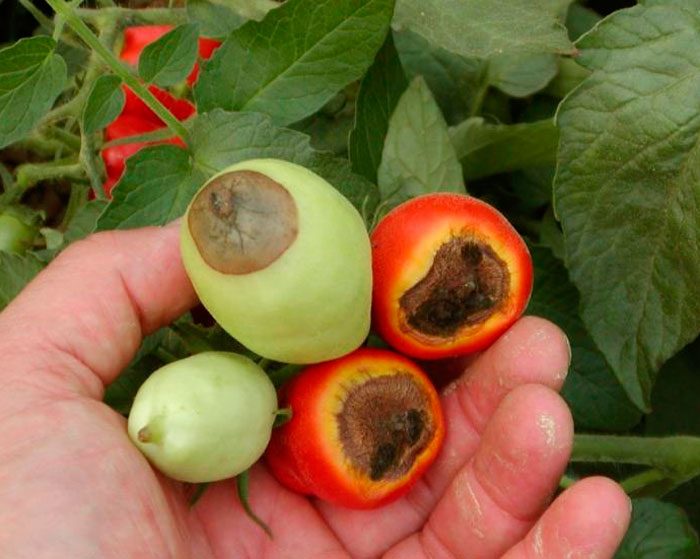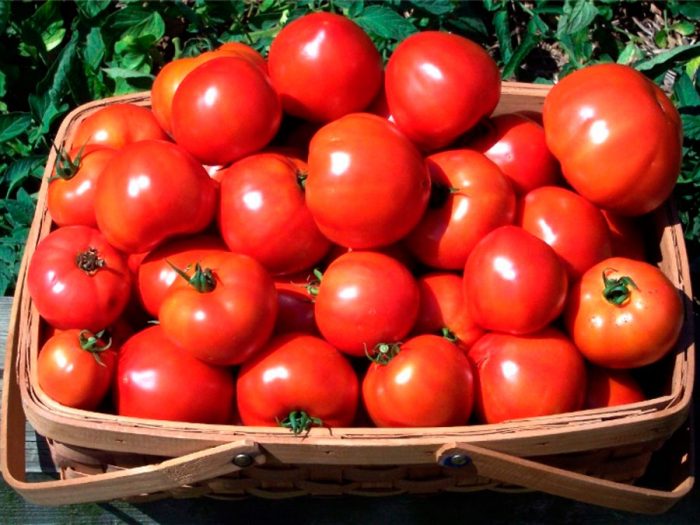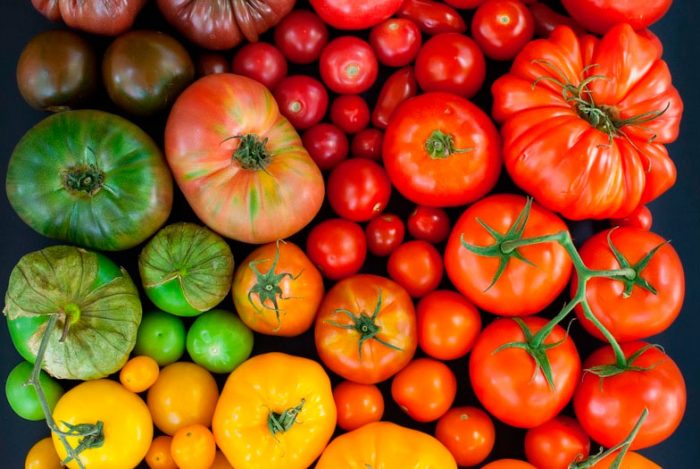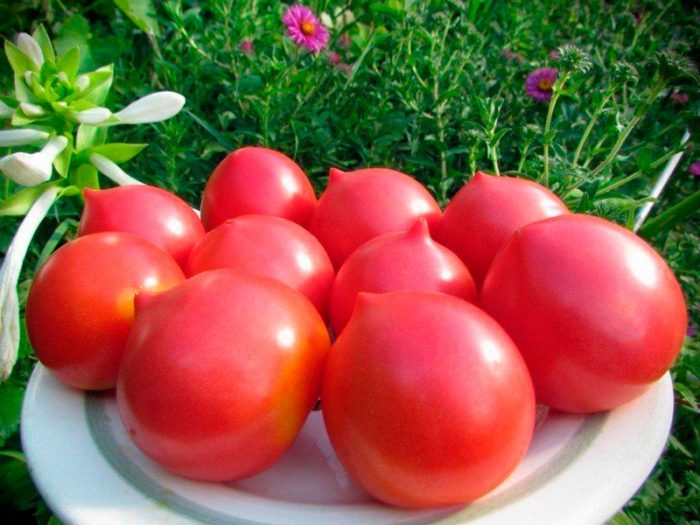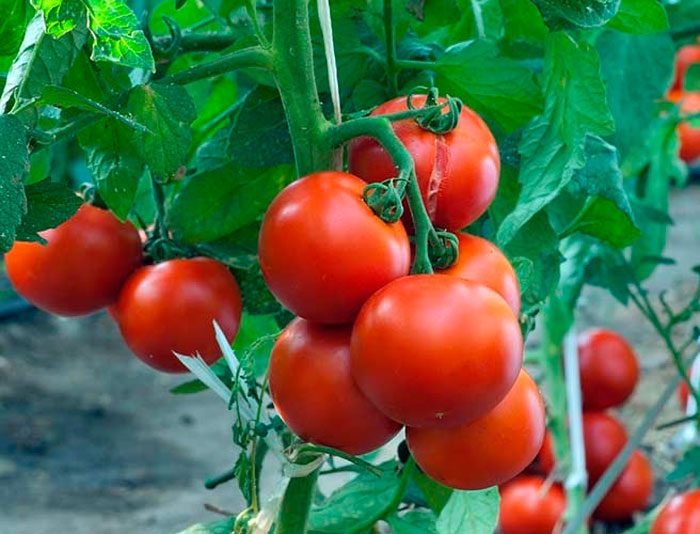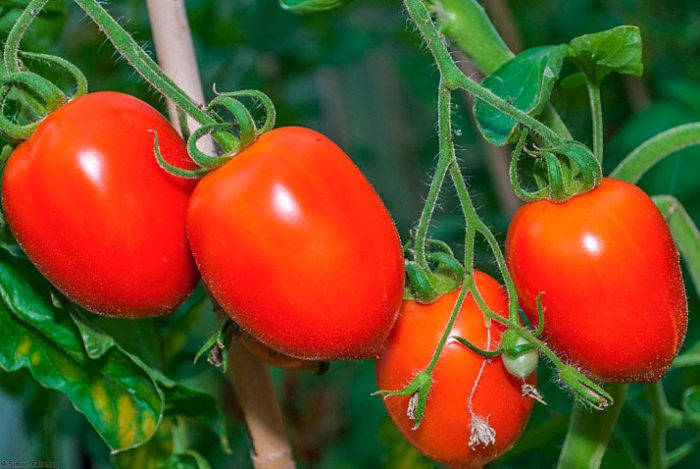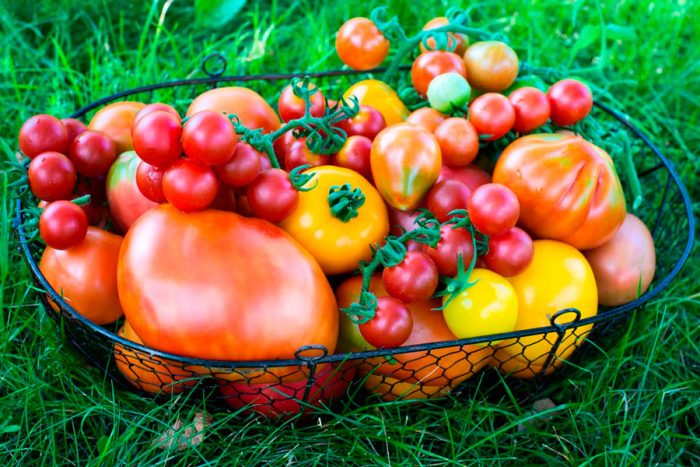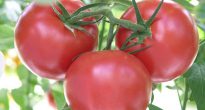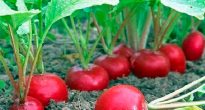Tomato or tomato (Solanum lycopersicum) is a type of herbaceous annuals and perennials that belongs to the genus Solanaceae of the Solanaceae family. This plant is grown as a vegetable crop and is very popular in all countries. The people call it "tomato fruit" - "pomo d'oro", which is translated from Italian as "golden apple". The name tomato comes from the Aztec "tomatl", it was improved by the French to its modern form. This culture comes from South America, and today it can still be found in natural conditions. The tomato was introduced to European territory in the middle of the 15th century. He ended up with seafarers in Spain and Portugal, and from there - to France, Italy and other European countries that are more remote from sea routes.
Previously, the tomato was grown as an exotic plant, since its fruits were considered inedible for a long time. In 1692, in Naples, a recipe for an allegedly Spanish tomato dish was first included in the cookbook. On the territory of Russia, such a culture appeared in the 18th century, at first it was grown as an ornamental exotic plant, since the fruits did not have time to ripen in severe weather conditions. But the outstanding Russian writer, naturalist and philosopher A.T. Bolotov I came up with the idea of growing tomatoes through seedlings, and also using the ripening method, which made it possible to achieve full ripening of the fruits.
Content
Planting and grooming at a glance
- Landing... Sow seeds for seedlings in the second half of March. Planting seedlings in open soil, depending on the variety, is carried out 45-60 days after the appearance of the seedlings.
- Illumination... Needs lots of bright sunlight.
- Priming... It should be warm, friable, saturated with organic matter, moderately moist and slightly acidic or neutral.
- Predecessors... The bad ones are representatives of the Solanaceae family, for example: tomatoes, potatoes, peppers, eggplants, etc. The good ones are carrots, onions, cabbage, cucumbers, zucchini, legumes.
- How to water... Watering should be systematically drip.For 1 bush, 1 liter of water is taken.
- Hilling... The first time you need to huddle 8-12 days after transplanting into open soil, when the tomatoes are watered. This procedure must be repeated 17–20 days after the first hilling.
- Stealing... 20 days after transplanting the seedlings into open soil.
- Mulching... You need to use organic matter: peat, grass or sawdust.
- Garter... You need to tie it to trellises or stakes, first at the level of the first sheet plate, then at the level of the second brush, and later at the level of the third brush.
- Fertilizer... The first time is 10–12 days after transplanting the seedlings into open soil, the second — half a month after the first, the third — 15 days after the second.
- Harmful insects... Tomatoes can be harmed by: scoops, thrips, wireworms, slugs, bears, rootworm nematodes and sprout flies.
- Diseases... The plant can infect late blight, brown, brown, white and black spots, white, gray, apical and stem rot, verticillosis, tracheomycosis, streak, bacterial cancer and viral mosaic.
Features of tomatoes
The rapidly forming pivotal ramified system of tomato roots extends to a depth of 100 cm and more, it grows 150–250 cm wide. The peculiarity of this plant is that additional roots can develop on any part of the shoot. In this regard, tomatoes can be propagated by seeds, as well as by cuttings and stepchildren. An erect or lodging branching stem can have a height of 0.3–2 m or even more. Unpaired leaf plates are dissected into large lobes; in some varieties, they are similar to the foliage of potatoes. The racemes are made up of small, unsightly flowers that can be colored in different shades of yellow. The flowers are bisexual, each with male and female organs. The fruit is a multi-celled berry that can be of various shapes, namely ellipsoidal, round and cylindrical. Fruit weight can vary from 30 to 800 grams. Depending on the variety, the fruits are colored orange, raspberry, greenish, deep yellow, brown, almost black, pinkish, deep red, white, yellowish, golden yellow or purple. The small and flat seeds are pointed at the base, they are colored in various shades of yellow, they have pubescence on their surface, which gives them a pale gray color. The seeds remain viable for 6–8 years. Tomatoes in the botanical sense are berries, but in 1893 the Supreme Court of the United States, and in 2001 the European Union decided to consider tomatoes as vegetables, not fruits, like all other berries.
Growing tomatoes from seeds
Sowing
Tomatoes in middle latitudes are grown exclusively through seedlings, since if the seeds are sown in open soil, then during the season their fruits will not have time to fully ripen. It is necessary to start growing tomato seedlings in the winter, while it should be borne in mind that 4 weeks after the second pick, they should be planted in open soil.
The timing of sowing tomato seeds for seedlings directly depends on the climatic conditions of each region. However, it must be borne in mind that in any case, if all the necessary conditions are observed, then the seedlings will need to be transplanted into open ground, depending on the variety, after 45–65 days from the moment of sowing the seeds. For example, in middle latitudes, sowing of tomatoes for seedlings is carried out on March 8-20. If tomatoes are grown in a greenhouse, the seedlings can be transplanted into it 30–35 days after they appear. It should be borne in mind that in regions with a short summer in open soil, it is recommended to grow large-fruited varieties of tomatoes, so if their fruits do not have time to fully ripen, they can be plucked brown from the bush and ripened. If you ripen small-fruited tomatoes, the fruits will become lethargic and lose their taste.And large-fruited varieties, even after ripening in room conditions, will be very tasty, sweet and juicy.
Seeds need pre-sowing preparation. To do this, within 48 hours they should be warmed up at a temperature of 30 degrees, then for 72 hours they are kept at a temperature of 50 degrees. Then the seed for 30 min. immersed in a solution of potassium manganese, which should have a pink color. Then they should be rinsed for 10 minutes. in running and clean water and keep in a solution of the drug that stimulates growth for several hours. For sowing seeds, a universal soil mixture is used, for example: which includes peat and sand (1: 1). To grow such seedlings, you can use a soil mixture, which consists of sawdust, peat and sod land (0.5: 7: 1). Also, seedlings grow very well in a soil mixture, which consists of humus, mullein, peat and sawdust (1: 0.5: 3: 0.5). Any substrate must be disinfected, for this it is calcined in a microwave or oven, while half a month before sowing seeds it must be spilled with EM-Baikal solution (1%). The freezing method can also be used to sterilize the substrate. To do this, the container with the soil mixture is transferred outside in the first winter weeks, while in the spring it is brought into the room, and when it warms up well, seeds can be sown.
The seedling boxes must be at least 10 centimeters high. If there is enough space, then you need to sow seeds sparsely, and if possible, it is recommended to use peat tablets for this, reaching 3.3-3.6 cm in diameter, put 2 or 3 seeds in each of them, in this case seedlings will not be needed dive. The seeds should not be buried too deeply into the substrate. They are evenly distributed over the surface of the moistened substrate, then covered with a thin layer of vermiculite or substrate, while the layer thickness should be from 0.3 to 0.4 cm. Crops from above should be covered with a paper sheet or foil.
Growing tomato seedlings
If tomato seedlings are looked after well and correctly, this will have a beneficial effect on the quantity as well as the quality of the crop. Before the seedlings appear, the crops should be provided with an air temperature of about 25 degrees. After the shoots appear, and this should happen after 5-7 days, the shelter from the container must be removed (it is recommended to do this in the afternoon), then the seedlings are transferred to a well-lit place with diffused light, while within 7 days they should ensure the following temperature regime: at night - 8-12 degrees, and in the daytime - 10-15 degrees. A week later, the following temperature regime should be set: on rainy days - from 18 to 20 degrees, on fine days - from 20 to 25 degrees, and at night - from 14 to 16 degrees. The room is systematically ventilated, and do not forget to protect the seedlings from drafts. The crops should be watered with well-settled water at room temperature; for this, a fine-dispersed spray is used. Watering is carried out only once every 7 days. But it should be borne in mind that after the seeds are sown in a moistened substrate and before the first true leaf plate appears, there is no need to water the crops. After the plants have 5 true leaf plates, they are watered only once every 3-4 days.
In some cases, the seedlings will need to provide additional lighting, since in order for them to develop normally, they will need 12-16 hours of daylight. In the absence of the opportunity to organize additional lighting, seedlings will need feeding, for this they use potash fertilizer in a weak concentration. After the tomatoes grow up, it is necessary to pour a layer of substrate into the boxes, the thickness of which should be from 10 to 20 mm, thanks to which the seedlings will be more stable.
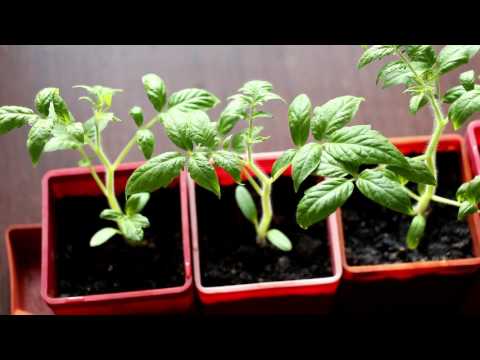

Watch this video on YouTube
Picking tomatoes
It is necessary to dive the seedlings during the development of their second true leaf plate. Gardeners have different opinions about whether it is necessary to dive tomato seedlings. Whether the seedlings need a pick can be found out empirically, for this, half of the tomatoes must be left in the seedling box, adding the substrate to it, and the rest of the plants must be transplanted into individual cups, the volume of which should be at least half a liter, but if you take a smaller capacity, then the tomatoes will have to transplant 2 times. Thanks to this experience, it will be possible to understand in which case the plants will develop faster and better.
Before you start picking seedlings, the substrate in the seedling box must be watered very well. You can dive the plant in separate cups, 1 or 2 pieces. If 2 seedlings are planted in a container, then when their length reaches 10-15 centimeters, their stems need to be tied very tightly to each other, for this they use a synthetic thread. After the two stems grow together into one, the thread must be removed, as a result you will have a bush with two root systems and a strong stem.
For 7 days, the cut plants should be provided with the following temperature regime: on fine days - from 25 to 27 degrees, on rainy days - from 20 to 22 degrees, and at night - from 14 to 17 degrees. After a week, you should return to the previous temperature regime. Half a month before transplanting tomatoes into open soil, they need to begin to prepare for new conditions. To do this, you will need to gradually reduce watering, every day for a short time they should be transferred outside under direct sunlight, seedlings will also need feeding with a nutrient mixture consisting of 1 liter of water, 7 grams of potassium sulfate, 1 gram of ammonium nitrate and 4 grams of superphosphate, and also preventive treatment with a solution of Bordeaux mixture (1%) from harmful insects and diseases.
Growing tomatoes on a windowsill
Various vegetable crops are suitable for indoor cultivation, for example: cucumbers, hot peppers, tomatoes, sweet peppers, etc. Tomatoes are light-requiring, therefore it is recommended to grow them on a windowsill located in the southern part of the building, since they need very good lighting, and straight they do not need the rays of the sun. In autumn and winter, daylight hours are very short, so in order for the tomatoes to develop normally, they need backlighting, for this they use a fluorescent lamp or an agro-lamp. For growing at home, it is recommended to choose undersized or dwarf varieties, for example: Little Florida, Dubok, Pearl red or yellow, Pinocchio, and also hybrids: Balcony miracle, Bonsai and Bonsai micro.
Take a glass and fill it with soil mixture, which includes sand, turf soil, peat or humus, they must be taken in equal parts. The substrate in containers must be spilled with freshly boiled water, then you must wait until it cools completely, and then distribute the seeds over the surface. If the seeds are germinated, then in each cup you will need to place them 1 piece, and when sowing non-germinated seed material - 2 or 3 pieces. The seeds need to be buried in the substrate only 20 mm. For germination, the seeds are placed in a moist cloth, where they will stay for several days until small sprouts appear. However, first, the seeds must be checked for germination, for this they are placed in a pinkish solution of potassium manganese for a quarter of an hour. After the allotted time, viable seeds should swell and sink to the bottom, while non-viable ones will float up. Then the containers with crops must be removed to a warm place (from 25 to 30 degrees), they are covered with film or glass on top. 3-5 days after the seedlings appear, the cups must be removed on the windowsill, on which a device for additional lighting should be installed in advance.
Watering is carried out only after the top layer of the soil mixture has completely dried. Plants should be watered with a rubber medical pear, for this they use well-settled water at room temperature, which should be carefully introduced between the walls of the container and the substrate. Thanks to such watering, it will be possible to avoid blurring the substrate, as well as waterlogging of its upper layer. You can also use the pallet method to water tomatoes. Fortified plants will need to be transplanted into larger containers. If the plants are undersized, then for their transplant, you can use containers with a volume of 3-5 liters, while vigorous ones will need pots from 8 to 12 liters. A good drainage layer should be made at the bottom of the container, which is covered with a two-centimeter layer of sand. After that, a seedling, taken together with a lump of earth, is transplanted into the container by transferring, then so much substrate is poured into it so that it is full and does not have voids. It is necessary to deepen the plant into the soil in cotyledonous leaf plates.
Over time, it will be necessary to systematically pinch the bushes, for this you should remove those shoots that grow in the leaf sinuses. They need to be broken by hand, while the remaining stump should be about 1–2 cm long. This stimulates the growth of the main shoots, as well as increases the yield of the bush. During the day, tomatoes are recommended to provide a temperature of about 28 degrees, and at night - 15 degrees. They are watered 2 or 3 times in 7 days, for this they use well-settled water at room temperature, while you need to be extremely careful so as not to blur the surface of the substrate. It is necessary to feed the tomatoes once a decade, for this they use organic matter or mineral fertilizers, remember that it is imperative to monitor the concentration of the solution, otherwise the active growth of greens may begin, which negatively affects fruiting. If the stem of the bush has become unstable, it must be tied to a support. In order for the flowers to be accurately pollinated, it is necessary to gently shake the bushes a couple of times every 7 days. After most of the fruits are formed, experts advise that you cut off the tops of the bushes, as well as flowering brushes. A home-grown tomato, if properly cared for, will bear fruit for five years, but usually the first 2 years are most productive.
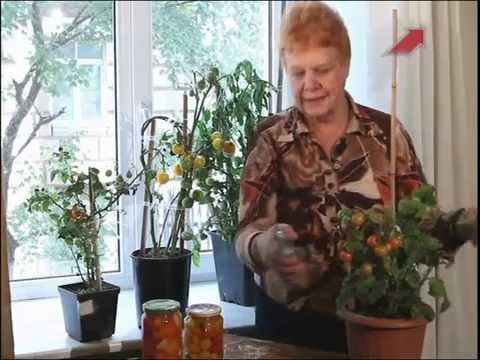

Watch this video on YouTube
Planting tomatoes in open ground
What time to plant
The planting of tomato seedlings in open soil is carried out in June after the return spring frosts are left behind, while warm weather should be established. Seedlings by this time should have a developed root system, 7–8 leaf plates and stems 25–30 centimeters high, and they should also begin to form clusters.
To grow tomatoes, you need to choose a sunny and well-heated area, which should be protected from the wind. It should be noted that cabbage, legumes, onions, carrots, beets, turnips and other root crops are good predecessors of this culture. An area where crops belonging to the Solanaceae family, such as eggplant, peppers or potatoes, have been grown, can only be used for growing tomatoes after 3 years.
Suitable soil
It is recommended to grow tomatoes in a soil saturated with organic substances. It should be noted that such plants rapidly select all nutrients from the soil, in this regard, compost or humus is introduced into it in advance (per 1 square meter of the plot from 4 to 6 kilograms) and mineral fertilizers, namely, 20 grams of phosphorus and potassium fertilizers that should be applied to the soil in the fall during digging 6 months before planting tomatoes, and another 10 grams of nitrogen fertilizers in spring in the year of planting tomatoes per 1 square meter.Organic matter is introduced into the soil in October during the digging of the site, while you need to try to make the clods of earth large, in spring you should loosen the soil twice to a depth of 10 centimeters, while nitrogen fertilizer is applied to it. If organic fertilizers are applied to the soil every year, then the same plot can be used for growing tomatoes for 2 or 3 years in a row, but then a break is taken, which should last at least three years.
Landing rules
In the prepared area, you need to make planting holes, the depth of which should be equal to the height of the cups in which the seedlings grow. Then they must be thoroughly spilled with water. Between the pits, a distance of 0.3 to 0.4 m should be observed, and the row spacing should be about 0.5–0.6 m. If the height of the bushes is about 0.3 m, then they are planted in the pits at a right angle. In this case, the seedlings of vigorous varieties, and even elongated bushes, must be planted at an angle, while the top of the plants is directed to the south, and the stem is buried in the soil by ¼ or 1/3 part. After planting tomatoes in the ground, it is tamped and watered abundantly. It is necessary to install pegs near the bushes of vigorous varieties, in the future they will be used as a support. The following number of bushes are planted per 1 square meter of the plot:
- hybrids, as well as vigorous varieties - 3 or 4 pieces;
- varieties in which 2 or 3 stems are formed on the bush - from 4 to 6 pieces;
- varieties that form 1 stem, as well as with limited growth of the main stem - 6-10 pieces.


Watch this video on YouTube
Growing tomatoes in a greenhouse
It is necessary to plant tomato seedlings in the greenhouse in the first decade of May. It should be noted that at the end of spring at night it is still quite cool, in this regard, the greenhouse must be covered with two layers of film, while the gap between them should be from 20 to 30 mm. When the weather is warm (as a rule, this happens already in the first days of June), you can remove the top layer of the film. You also need to take into account that it is forbidden to grow tomatoes and cucumbers in the same greenhouse. The fact is that cucumbers need higher humidity and air temperature compared to tomatoes, and they also have significantly different ventilation modes. Tomatoes also need a lot of light, and if they are even slightly shaded by tree branches or shrubs, this will have an extremely negative effect on the harvest.
It is not recommended to grow tomatoes in a greenhouse bed after any predecessor. If it is not possible to change the entire substrate, then you need to at least change its top layer with a thickness of 10 to 12 centimeters, this will avoid damage to the bushes by anthracnose. Then you need to disinfect the soil with a freshly boiled solution of 1 bucket of water and 1 tbsp. l. copper sulfate or 2 Oxychom tablets. When preparing the soil for planting, 1 tsp should be added to it. urea or potassium nitrate, 1 tbsp. l. potassium sulfate, 3 tbsp. l. double superphosphate granules, 1 tbsp. l. kalimagnesia and 2 tbsp. wood ash.
Planting standard-sized seedlings in a greenhouse is carried out in the same way as in open soil. Overgrown or elongated plants are planted as follows: at the bottom of the planting hole, another hole must be made, its size should be equal to the size of the container in which the plant is grown. In this hole it is necessary to plant a plant with a peat pot or with a lump of earth. After that, you need to fill the lower hole with soil, while the upper one should remain completely open. After half a month, after the complete adaptation of the planted seedlings, it will be possible to fill in the upper hole. If the overgrown bush is buried to the required depth immediately, then after that, the formation of additional roots will immediately begin, and since the bush spends almost all its strength on this, it takes root much longer and worse.
The bushes planted in the greenhouse cannot be watered for 15 days, after which the plants are tied to a support, the height of which should be about 200 cm. After that, single-stem bushes are formed, on which there should be 7 or 8 brushes. In this case, it is necessary to cut out all the forming stepchildren, from which short stumps (10–20 mm) should remain. To make sure that the flowers are accurately pollinated, you need to gently shake the flower brushes and then water the soil or moisten the flowers using a fine spray. After 2 hours after that, it is necessary to reduce the level of humidity in the greenhouse, for this it is ventilated. Remember that when arranging the greenhouse, together with the side vents and doors, you need to make ceiling vents in it, which will prevent the accumulation of condensation on the film. Otherwise, excessively high air and soil humidity can lead to the fact that the fruits become watery and become sour in taste.
Before bud formation begins, tomatoes need to be watered once every 5–7 days, with 4 to 5 liters of water taken per 1 square meter of plot. As soon as the bushes bloom, when watering them per 1 square meter of the plot, you will need to take from 1 to 1.5 buckets of water. In order for them to grow well, the air temperature in the greenhouse should be around 20-22 degrees.
During the growing season, tomatoes will need to be fed 3 or 4 times using the root method. 20 days after transplanting seedlings into greenhouse beds, it should be fed for the first time, for this, a nutrient solution is used, consisting of 1 bucket of water, 0.5 liters of liquid mullein and 1 tbsp. l. nitrophosphate. After half a month, the bushes must be fed again, for this they use a solution consisting of 1 bucket of water, 1 tsp. potassium sulfate and 1 tbsp. l. complete mineral fertilizer. The third feeding is carried out after another 15 days, for this you will need a nutrient solution consisting of 1 bucket of water, 1 tbsp. l. superphosphate and 2 tbsp. l. wood ash. For 1 square meter of land, approximately 6 to 8 liters of nutrient mixture are taken. In order for the fruits to ripen (fill) faster, during the period of full fruiting, they will need top dressing, for this, a nutrient mixture of the following composition is taken: 1 bucket of water, 1 tbsp. l. liquid sodium humate and 2 tbsp. l. liquid superphosphate, while 5 liters of a similar mixture are taken per 1 square meter of the garden.
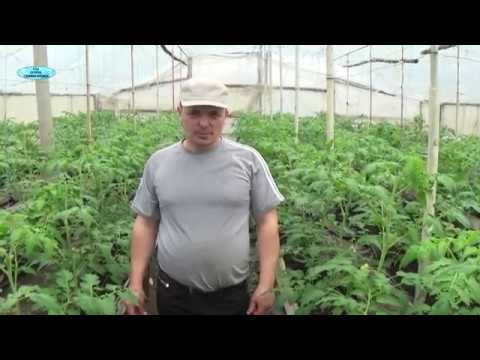

Watch this video on YouTube
Tomato care
When growing tomatoes in open ground, they must be systematically watered, fed, weeded, loosened the soil surface and protected from diseases and harmful insects. Also, the bushes must be spilled and shaped. It is necessary to loosen the soil surface between plants and bushes several times during the growing season (once every 10–12 days), which will promptly destroy the crust that forms on the soil. Along with loosening the soil, you need to pull out all the weeds. The bushes should be piled up for the first time 8–12 days after transplanting tomato seedlings into open soil, this should be done the next day after watering. The second hilling of the bushes after watering is carried out 2.5–3 weeks after the first.
It is also necessary to carry out the formation of tomatoes. In regions with a relatively warm climate, such a crop can be grown in several stems. However, if the climate is cool enough, then it is recommended to grow tomatoes in 1 stem, while leaving 2 or 3 flower brushes on it, and do not forget to cut out all the stepchildren, otherwise a large amount of tops will have an extremely negative effect on the harvest. The first pruning of side stepchildren is carried out 20 days after transplanting seedlings into open soil after their length is 50–70 mm. Strong-growing varieties need not only pinching, but also pinching the growing point, which is carried out in the first days of August.When growing climbing varieties in bushes, you need to cut off all the lower leaf plates, this is a good prevention of fungal diseases, and thanks to this, the access of air and sunlight to the plant will improve. This will contribute to the fact that the harvest will be higher and earlier.
How to water
Tomatoes grown in open soil need to be watered systematically. You need to pour water into the holes, while 1 liter of water is taken for 1 bush. Watering is recommended in the afternoon or on a cloudy day. Mandatory watering must be done before proceeding with loosening, during the flowering period of the first and second flower clusters, and even after dry fertilizer has been applied to the soil.
It is best to water these plants with a drip method. Due to this, the liquid enters the soil rather slowly, in this regard, there is no sharp change in air humidity, which has an extremely negative effect on tomatoes. In addition, there is no stagnation of liquid on the surface of the soil, and this is a good prevention of fungal diseases.
It is recommended to mulch the surface of the soil around the bushes with black covering material, due to this, the growth of weeds completely stops, and moisture is retained in the soil. If the surface of the site is mulched with organic matter (for example: sawdust, grass or peat), then this will contribute to the attraction of earthworms, which loosen the soil and produce humus in the course of their life, and tomatoes are in great need of it. But it should be borne in mind that moles can settle in an area with a large number of earthworms.
Garter rules
For garter tomatoes, you can use trellises or stakes. It is recommended to install stakes on the north side of the row, while keeping a distance of 9 to 11 centimeters between them and the shoots. To make trellises, you need stakes, which are installed every 4 meters, then you should pull threads or ropes between them. Bushes are tied in 3 stages:
- after transplanting seedlings into the ground at the level of the first leaf plate;
- at the level of the second flower brush;
- at the level of the third flower brush.
Top dressing of tomatoes
The first time it is necessary to feed the seedlings 10-12 days after transplanting it into open soil. To do this, use a nutrient mixture consisting of organic matter and mineral fertilizers; for its preparation, it is necessary to add 20 grams of superphosphate to 1 bucket of mullein solution (slurry and water, taken in a ratio of 1: 8 or 1: 9). For 1 bush, 1 liter of such a mixture is taken. The second time the plant is fed half a month after the first feeding, and the third time - after the same period of time, for this they use dry mineral fertilizers, they are evenly distributed on the surface of the garden: 10 grams of ammonium nitrate, 20 grams of superphosphate are taken per 1 square meter of the plot and 15 grams of potassium salt. Then the surface of the soil must be loosened to cover the fertilizer, after which it is well spilled.
If there is a lack of any element in the soil, or there is too much of it, this may affect the appearance of the bushes. For example, if there is little sulfur in the soil, the foliage on the bushes will turn red or yellow, and the shoots will become very fragile. If boron is not enough in the soil, the shoots at the growth point will turn black, the cuttings of young leaf plates will become fragile, while brown specks form on the surface of the fruit. If there is not enough molybdenum, then the leaf plates will turn yellow and wrap up, also because of this, the bushes can be affected by chlorosis, as with a lack of iron, when the color of the foliage changes to almost white, while the tomatoes do not ripen, and their growth stops.If signs of a shortage of any of the elements are found, the bushes will need to be fed according to the foliage, while using a mixture that contains the missing element.


Watch this video on YouTube
Treatment
In regions where the climate is rather cool, in some cases tomatoes do not have time to ripen. To save the harvest, the bushes can be treated with a special mixture that will accelerate the ripening of the fruit. To do this, you need young pine shoots, which you need to put on the refrigerator shelf for 7 days. They should be cut into small pieces and mixed with water in a 1: 2 ratio. The mixture must be brought to a boil, after which it is simmered over low heat for 5-10 minutes. The cooled and strained broth must be diluted with water in a 1: 3 ratio. During the formation of buds, treat the bushes with this mixture.
Pests and diseases of tomatoes
Diseases
The most common diseases in tomatoes are brown, brown, black and white spots, mosaic (because of it, plants crumble), tracheomycosis, bacterial cancer, southern and common late blight (bushes begin to dry out), white, stem, gray and apical rot, verticillosis and streak. Each of these diseases has its own symptoms and treatments. However, it must be remembered that if you strictly adhere to the rules of prevention and agricultural technology of a given culture, then it will be possible to avoid infection of the plant altogether.
Pests
Most often, tomato bushes are home to thrips, sprout flies, bears, scoops, wireworms, slugs and rootworm nematodes. It is recommended to fight such harmful insects with folk remedies, namely: herbal infusions and decoctions, which have a fungicidal, insecticidal and antifidant effect.
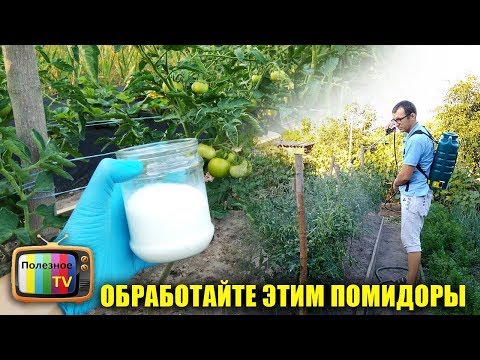

Watch this video on YouTube
Collection and storage of tomatoes
All flowering stems and buds must be removed 20 days before harvesting tomatoes, thanks to which the formed fruits will ripen faster. Fruits are harvested selectively, as the tomatoes ripen to brown, pale yellow, pink or milky. Such fruits ripen well in 7-15 days, while they remain sweet and tasty. If you collect green tomatoes from the bushes, then after ripening their taste will be lower. All fruits should be harvested before the temperature starts to drop to 8 degrees at night, as this temperature increases the risk of plant damage by various diseases. Most gardeners recommend harvesting the entire crop before the "cold dawn", otherwise it may die. But it should be borne in mind that the ripening of each of the varieties occurs in due time. For example, the collection of early ripening varieties is carried out in the second half of July, the average ripening period is in the last days of July or the first days - August, late - in August or September.
Ripe tomatoes must be laid with their spouts down; for this, plastic boxes or cardboard boxes are used, the bottom of which must be covered with paper sheets, while no more than 12 kilograms of tomatoes are placed in each container, otherwise the pressure on the bottom row will be excessively strong.
Ripe tomatoes should be stored no more than 7 days before conservation, processing or fresh consumption. Pink and brown fruits that have been placed on ripening ripen much faster compared to green or milky white ones. It is recommended to dose and store non-injured and large tomatoes that are plucked from the bushes along with the stalks. For ripening, the fruits are put in cardboard boxes, which must be covered with lids. In the middle of the box, 3 or 4 ripe fruits are placed, which produce ethylene, which helps accelerate the ripening of tomatoes.If you put the fruits in plastic boxes or in wicker baskets, then they are covered with a dense material on top, for example, burlap, it will prevent ethylene from volatilizing. In a warm room, the fruits ripen much faster. Fully ripe pink fruits will be in about five days, brown - after 7 days, and in the degree of milk maturity - after 1.5 weeks.
In order for the fruits to survive until the second half of December, paper sheets must be laid between the layers. They need to be removed to a cool place, for example, in a dry cellar, on a glassed-in balcony, or on a cold veranda. If the fruits are stored for a long time, then they should be systematically sorted out, which will allow timely removal of rotten specimens that can rot all other tomatoes.
Types and varieties of tomatoes
There are several types of tomato classifications. The classification of the American scientist C. Rick divides all tomatoes into 9 types. In Russia, a traditional classification has been adopted, according to which all tomatoes are divided into 3 types, namely, Peruvian tomato, ordinary and hairy. Today, there are more than 70 hybrids and varieties of ordinary tomatoes, and these are only those tomatoes that are intended for growing in the open field.
Still such a plant is divided according to its structure into non-standard, standard and potato-like.
- Stamp tomatoes... They are represented by compact bushes with very thick shoots, as well as medium-sized corrugated leaf plates located on short petioles. This group is quite numerous, it includes dwarf and medium-sized hybrids and varieties that form a small number of stepchildren.
- Non-standard tomatoes... Their foliage is large and slightly corrugated. The shoots are thin, and they lie under the weight of the tomatoes. This group is represented by dwarf and vigorous varieties, as well as hybrids. Today there are half-stemmed tomatoes, which are something in between the standard and non-standard types.
- Potato Tomatoes... Large leaf plates are similar to potato ones. These types are rare.
Still varieties are divided according to the type of growth of bushes into deterministic (low-growing) and indeterminate (tall). Also in this group there are varieties of superdeterministic and semi-determinate. However, only specialists use this classification.
Tomatoes are also divided according to the ripening time into early ripening, medium ripening and late ripening.
Early maturing varieties
- Irma... Large or medium-sized fruits ripen in 100 days. The height of the bush is from 0.5 to 0.6 m, it does not need pinching. The variety has good keeping quality. The fruits are suitable for autumn salads, canning in their own juice and freezing whole fruits.
- Zest... The height of the bushes varies from 0.5 to 0.8 m. Heart-shaped dense tomatoes are red in color, they weigh about 100 grams. The watermelon pulp is sweetish and very tasty. The fruits are suitable for preservation and for making salads.
- Butuz... The high-yielding bushes reach a height of 0.5 to 0.6 m. Barrel-shaped red fruits weigh from 100 to 200 grams, their keeping quality is excellent, as is the taste.
The best varieties of medium ripening
- Bull heart... Juicy and soft tomatoes are of medium and large size, they have a red-pink color, thin skin and a wonderful sweetish taste. The variety has excellent yields, but this variety has a low resistance to brown spot.
- Lady fingers... On the half-meter bushes, which do not form stepchildren, there is a relatively small amount of foliage. Red tomatoes are pear-shaped and have firm, dense flesh. Perfect for preservation.
- Koenigsberg... The height of a bush of such a vigorous variety is from 150 to 200 cm. Red elongated tomatoes have a shape similar to eggplant. They taste great and weigh about 0.3 kg.
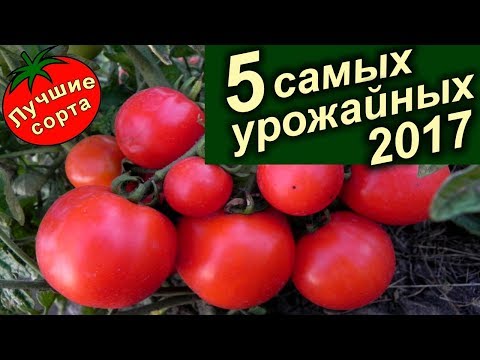

Watch this video on YouTube
The best late-ripening varieties
- De Barao... The height of strong bushes is about 400 cm. Smooth plum-shaped fruits with dense, delicious pulp, they weigh about 70 grams. The variety is resistant to cold and shade-loving. The fruits are suitable for whole-fruit preservation, for fresh consumption and for long-term storage.
- Finish... Plant height is about 0.75 m. Delicious red-orange fruits weigh about 90 grams. This variety is fruitful and resistant to verticillium.
- Cherry... This is a very popular variety with excellent taste and decorative qualities of sweet small fruits that weigh about 30 grams, they are collected in a brush. For conservation, they are used with a branch. The variety is grown on the balcony, in the open field and in the greenhouse.
There are also interesting and rather unusual varieties.
- Banana (pepper) tomatoes... The fruits have an unusual shape and taste. Popular varieties: Jersey Devl, Auria, Uncle Stepa.
- Ribbed tomatoes... The variety is distinguished by its productivity and large fruits, which are similar in shape to a peeled orange with very convex slices. Popular varieties: Tlacolula, American ribbed.
- Orange tomatoes... They are high in lycopene, sugar and beta-carotene compared to conventional varieties. They are recommended for people who are allergic to red fruits. The most popular variety is Persimmon.
- Yellow tomatoes... Golden tomatoes have a rich flavor. They contain many carotenoids and lycopene. These fruits are good for allergy sufferers. Popular varieties include: Golden Domes, Honey Drop, Wonder of the World, Goldfish.
- White tomatoes... The fruits have an unusual taste, they contain a large amount of sugar and are completely free of acid. Popular varieties: White Snow, White Bull Heart, Snow White.
- Black tomatoes... The fruits contain more beta-carotene, ascorbic acid and other vitamins compared to all other varieties. Such varieties are also appreciated for their unusual taste. However, such hybrids have low yields and low frost resistance. Fruits ripen very late, so it is recommended to grow such tomatoes outdoors only in regions with warm climates. Popular varieties: Raj Kapoor, Gypsy, Black Prince, Blue Sky.
- Green tomatoes... The fruits never turn red, they have a unique taste. Popular varieties: Emerald Apple, Swamp.
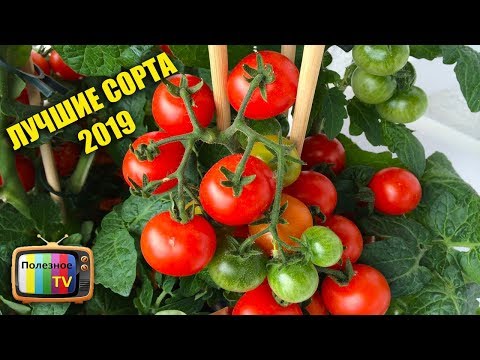

Watch this video on YouTube

